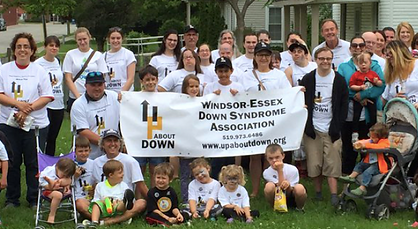This page will allow you to find information about resources in the Windsor-Essex community for vulnerable populations such as individuals with disabilities/special needs and the aging population. It also provides insight into how a typically day might look like with the types of care needed and how to continue to live a healthy life.
Resource Information

Resources
How health resources are applicable to both the youth and aging population

1
Caring for Someone with Dementia or Alzheimer's
Caring for a loved one who is expecting signs of Dementia or Alzheimer's is often difficult when there are little to no resources available to help guide the family to provide support. Click on this link to find out how you can apply for government assistance with respite care! Home Instead Senior Care directly connects families with supports in the community!
2
Community Resources for Youth
Struggling with finding support within the community to support your child and their needs? You've come to the right place, click on the link below to learn about events and support services happing across Windsor-Essex that support children with special needs! All these programs are supported by respite workers like me!
3
Ontario Caregiver Organization
The Ontario Caregiver Organization is what I belong to and they help by providing support in order to ease the burnout Caregivers experience. They create a 24/7 hotline available to caregivers to seek assistance at any point in time. They also host webinars, podcasts, and aid in supplying mental health resources. To find out more about the services offered click on the link below!
What is Health?
Understanding how the WHO (World Health Organization) defines health with respect to physical, social, and mental well-being
What is health and why is it so important to live a healthy lifestyle?
How to measure your health in different ways and understand what is considered a healthy range
Social Determinants of Health
This article examines how the social determinants of health affect morality and morbidity during the Covid-19 pandemic. Link can be accessed by clicking on the photo above.
This reference explains how the covid-19 pandemic has exposed the health effects of longstanding social inequities. It shows how vulnerability to disease is shaped by labour market structures, lack of social protection, and anti-democratic processes.
This paper speaks on how different racial/ethnic groups experienced psychological distress during the pandemic due to underlying social determinants.
Levels of Health Influences
Centers for Disease Control and Prevention. (2022, April 13). Justice, equity, diversity, and inclusion in climate adaptation planning. Centers for Disease Control and Prevention. Retrieved February 18, 2023, from https://www.cdc.gov/climateandhealth/JEDI.htm
World Health Organization. (2022, June 16). The impact of covid-19 on mental health cannot be made light of. World Health Organization. Retrieved February 18, 2023, from https://www.who.int/news-room/feature-stories/detail/the-impact-of-covid-19-on-mental-health-cannot-be-made-light-of
Azétsop, J., & Joy, T. R. (2013). Access to nutritious food, socioeconomic individualism and Public Health Ethics in the USA: A common good approach. Philosophy, Ethics, and Humanities in Medicine, 8(1), 16. https://doi.org/10.1186/1747-5341-8-16
Heinrich Böll Stiftung. (2019). Gender Responsive Climate Finance. YouTube. YouTube. Retrieved February 18, 2023, from https://www.youtube.com/watch?v=YKmvdiXlDFI.
Wolfe, D. (2021, June 25). Clean water: What happens to humans without it? World Vision Canada. Retrieved February 18, 2023, from https://www.worldvision.ca/stories/clean-water/clean-water-facts-impact-future
Australian Unity. (2022). What is Real Wellbeing - Relationships. YouTube. Retrieved February 18, 2023, from https://www.youtube.com/watch?v=DesotWjUGnw.
Dementia in Elderly Residents in Long-Term Care Homes
As a caregiver, I chose to find resources about dementia as my chronic disease among elderly residents in long-term care facilities in Canada. Read about the different treatments for dementia related behaviours below and click on the photos to directly access journal articles with the full information!
Indigenous Health Resources
-
This first article highlights the barriers indigenous individuals face when it comes to accessing healthcare services. Issues of discrimination, racism, low levels of education/income, transportation, and much more are discussed in relation to the social and cultural determinants of health directly and indirectly impacting Indigenous communities.
Davy, C., Harfield, S., McArthur, A., Munn, Z., & Brown, A. (2016). Access to primary health care services for Indigenous Peoples: A framework synthesis. International Journal for Equity in Health, 15(1). https://doi.org/10.1186/s12939-016-0450-5
-
The second reference listed here expands upon eight key characteristics that showcase the complications Indigenous populations face in respect to providing comprehensive primary health care. The eight characteristics include access to health services, community participation, continuous quality improvement, culturally appropriate and skilled workforce, flexible approach to care, holistic health care, and self-determination and empowerment.
Harfield, S. G., Davy, C., McArthur, A., Munn, Z., Brown, A., & Brown, N. (2018). Characteristics of indigenous primary health care service delivery models: A systematic scoping review.,(1). https://doi.org/10.1186/s12992-018-0332-2
-
The last article included takes on a more positive perspective and looks at how Indigenous-led primary healthcare services can be more effective at addressing health inequities. So far, in Canada both the First Nation Health Authority) and Colombia (Anas Wayúu) are Indigenous-led and provide coverage for primary, secondary and tertiary healthcare services, as well as health promotion programs.
Lavoie, J. G., Kornelsen, D., Wylie, L., Mignone, J., Dwyer, J., Boyer, Y., Boulton, A., & O'Donnell, K. (2016, August 22). Responding to health inequities: Indigenous Health System Innovations: Global Health, Epidemiology and Genomics. Cambridge Core. Retrieved March 10, 2023, from https://www.cambridge.org/core/journals/global-health-epidemiology-and-genomics/article/responding-to-health-inequities-indigenous-health-system-innovations/A40483538BC2EAD8EB3F9A4ECE69676A


Marginalization of Disabled Individuals in Canada


1. Lack of employment opportunities
Individuals apart of the disabled community often face many barriers when it comes to seeking employment opportunities. According to Statics Canada, disabled peoples are more likely to settle for part-time instead of full-time employment, and have lower annual incomes overall. This static alone may frighten individuals and make them hesitant to apply for job opportunities, it is important to take a look at this reference as highlights the positives these individuals face in the workplace.
Commission, C. H. R. (2015, December 2). Government of Canada. Canada.ca. Retrieved March 19, 2023, from https://www.canada.ca/en/human-rights-commission/news/2015/12/persons-with-disabilities-continue-to-be-marginalized-in-canadian-society-chrc.html
2. Poverty among disabled individuals
This article explains how disabled peoples experience disproportionately high poverty rates compared to other individuals. It examines how poverty rates are two times higher, housing outcomes are worse and higher and additional expenses for basic needs of daily living are higher for those with a disability than persons without disability.
Scott, C. W., Berrigan, P., Kneebone, R. D., & Zwicker, J. D. (2022). Disability considerations for measuring poverty in Canada using the Market Basket Measure. Social Indicators Research, 163(1), 389–407. https://doi.org/10.1007/s11205-022-02900-1
3. Women's rights and access to healthcare
This reference highlights the significant shortage of guaranteeing disabled women’s human rights to access health care supports and services. It explains issues such as the attitudes and outlook some healthcare providers have, the accessibility of care and information, difficulty accessing support groups and more.
Gibson, B. E., & Mykitiuk, R. (2012). Health Care Access and support for disabled women in Canada: Falling Short of the UN Convention on the Rights of Persons with Disabilities: A qualitative study. Women's Health Issues, 22(1). https://doi.org/10.1016/j.whi.2011.07.011
Future Health Of Canada


Take a look at how technology is advancing our current health and future trends in Canada!
01
Remote Health Monitoring System
This first resource is about the Remote Healthcare Monitoring System that is used monitor chronic health issues such as diabetes in patients in order to provide increase diagnosis speed and a cost effective way. This is important as technology continues to evolve, it is important to incorporate it into our healthcare systems in order to better monitor patients and allow them to live more freely with less medical expenses and time waiting for appointments. This reference is a current healthcare trend that is in the works and continuing to develop for the use of chronically ill patients.
El-Rashidy, N., El-Sappagh, S., Islam, S. M., M. El-Bakry, H., & Abdelrazek, S. (2021). Mobile Health in remote patient monitoring for chronic diseases: Principles, trends, and challenges. Diagnostics, 11(4), 607. https://doi.org/10.3390/diagnostics11040607
03
PRESCRIBEIT®
This last article highlights the new online prescription service available in Canada. PrescribeIT® allows for individuals to have their prescriptions filled online and communications to be between clinics made seamlessly with updates patient information online and easily accessible. This will not only elevate the time waiting for pick-up, it will allow for all billing or insurance information to be up to date and taken care of without any hassles.
PRESCRIBEIT® is changing how healthcare professionals communicate. Physician Pulse. (2022, June 3). Retrieved March 23, 2023, from https://plus.telushealth.co/blogs/physician-pulse/en/prescribeit-is-changing-how-healthcare-professionals-communicate/
02
Portable Dialysis Machines
The second reference is centred around portable dialysis machines and although they have made dialysis available at home, this new invention is more about making the machine more compact and easier to manoeuvre between areas. This allows for individuals receiving dialysis to be at a location that is comfortable for them and allows them to be able to receive it on vacation. This is a huge step as it will allow for more room in our hospitals while still providing the same care these individuals need.
Haroon, S., & Davenport, A. (2018). Haemodialysis at Home: Review of Current Dialysis Machines. Expert Review of Medical Devices, 15(5), 337–347. https://doi.org/10.1080/17434440.2018.1465817



















